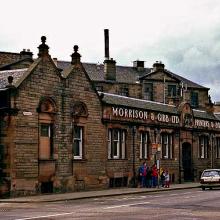
The drift bottle and message currently hitting the headlines for breaking the Guinness World Record as the ‘Oldest message in a bottle’ is of special Broughton interest, writes local retired marine scientist Jim Adams.
Clearly discernible on the image of the message that accompanied some of the media reports are the letters ‘M & G Ltd’; these show that the pre-printed parts of the message were the work of Morrison & Gibb Ltd, who occupied a site at Tanfield from 1896 to 1982.
But what are the origins of this ‘dilatory messenger’, to use an expression first used in 1916 to describe identical bottles which had been adrift, on average, for only seven years and a few months?
[img_assist|nid=3337|title=|desc=|link=node|align=right|width=501|height=640]Spurtle’s Issue 193 (p. 3) profiled T.W. Fulton, whose use of surface drifters in the 1890s led to his being credited with giving ‘a more complete account of the currents of the North Sea than was previously possible’. However, his attempts to trace the movements of the bottom waters using wooden slips and bottles weighted to sink proved unsuccessful.
Ten years later, Captain C.H. Brown – of the School of Navigation at the Royal Technical College, Glasgow, working on behalf of the Fishery Board, and using ‘Bidder’s bottom trailers’ – succeeded where Fulton had failed. These bottom drifters were similar to ordinary soda-water bottles, but carefully weighted with small shot placed in the neck so that they would float neck downwards. Attached to the neck of each bottle was a 24-inch-long ‘tail’ of copper wire, the weight of which caused the bottles to sink; but, as soon as the ‘tail’ touched the sea-bed, the bottles floated again. Thus the bottles remained floating a few inches above the sea-bed, and were carried along by the bottom currents until recovered by bottom trawl or washed ashore.
[img_assist|nid=3338|title=|desc=|link=node|align=right|width=154|height=200]Brown carried out three experiments between June 1906 and August 1914, and on the basis of bottle recoveries from the first two experiments he depicted a pattern of near-sea-bed currents in the northern North Sea that is remarkably accurate according to present-day concepts. However, the First World War interfered with the usual operations of the fishing fleet almost immediately after the last of the bottles for his third experiment had been released, and some 21 months after the April 1914 start of that experiment less than 2 per cent of the bottles had been recovered. This compared with the 20 per cent and 26 per cent recovered, respectively, from the first and second experiments after two to three years of their starting.
It is from this third experiment that the record-breaking bottles are being recovered, and in 1995 the Guinness Book of Records first verified one of these recoveries as a record. At the time it was noted that: ‘There are many of Captain Brown’s bottles still out there. Perhaps it will not be a record for long.’ This has indeed been the case, and, as the reports note, the most recent message breaks the record previously held for a bottle recovered in 2006 by the same Shetland fishing vessel!
Another bottle returned, in 1991, from the same experiment, prompted two colleagues and I to write a semi-popular article entitled ‘Drift Bottles from the Past’, available here.
In recent days, by the way, I have checked records at the Marine Laboratory and find that rewards were not offered at the time of these early experiments for the return of the drifters. Consequently, I and colleagues are at a loss regarding the claim in some media that there was a 6d reward available! Nevertheless, the Laboratory currently gives a token reward of £5 plus the cost of postage for any drifter returned.
[img_assist|nid=3339|title=|desc=|link=node|align=middle|width=640|height=504]
[Images courtesy of: 1. Peter Stubbs, www.edinphoto.org.uk; 3. & 4. Scottish Government.]